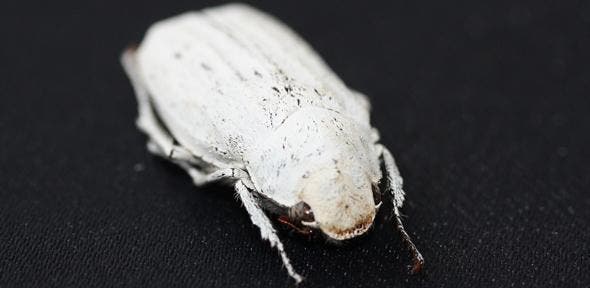The physical properties of the ultra-white scales on certain species of beetle could inspire researchers to make better, whiter paper, plastics or paint, using far less material.
The Cyphochilus beetle, native to South-East Asia, is whiter than paper or even milk teeth. The whiteness of its body is caused by a thin layer of a highly reflective natural photonic solid in its scales. A new team investigation the beetle and its scales found that the white scales are able to scatter light more efficiently than any other known biological mechanism, which is how they are able to achieve such a whiteness.
In nature, there are several animals which are very white; they have this color for varying purposes, such as camouflage, communication or thermo-regulation (in very hot areas). However, being white is a rather complicated thing – you have to reflect all wavelengths of light with the same efficiency. The ultra-white Cyphochilus beetle does this through a dense, complicated network of chitin – a molecule similar in structure to cellulose commonly found in nature in the shells of mollusks, on the exoskeletons of many insects and in the cell wall of fungi.
“These scales have a structure that is truly complex since it gives rise to something that is more than the sum of its parts,” said co-author Dr Matteo Burresi of the Italian National Institute of Optics in Florence. “Our simulations show that a randomly packed collection of its constituent elements by itself is not sufficient to achieve the degree of brightness that we observe.”
Chitin is not very good at reflecting light itself, but over millions of years of evolution, the beetles have developed a complex network with extremely thin chitin filaments. It’s important for insects, especially flying insects, to be very light, so the chitin network has to be very efficient and light, like a painter who needs to whiten a wall with a very small quantity of paint.
“Current technology is not able to produce a coating as white as these beetles can in such a thin layer,” said Dr Silvia Vignolini of the University’s Cavendish Laboratory, who led the research. “In order to survive, these beetles need to optimise their optical response but this comes with the strong constraint of using as little material as possible in order to save energy and to keep the scales light enough in order to fly. Curiously, these beetles succeed in this task using chitin, which has a relatively low refractive index.”
The exact mechanism through which they evolved this way still remains unknown – but that doesn’t mean that we can’t inspire technology from it. In recent times, many engineers have turned to nature for inspiration, with great results.
“The lessons we are learning from these beetles is two-fold,” said Dr Vignolini. “On one hand, we now know how to look to improve scattering strength of a given structure by varying its geometry. On the other hand the use of strongly scattering materials, such as the particles commonly used for white paint, is not mandatory to achieve an ultra-white coating.”
The results of this study could have a myriad of applications, most notably enabling white materials such as paper, plastics, paints, as well as white-light reflectors inside new-generation displays to be made whiter more efficiently with less material.
Journal Reference: Matteo Burresi,Lorenzo Cortese,Lorenzo Pattelli,Mathias Kolle,Peter Vukusic,Diederik S. Wiersma,Ullrich Steiner& Silvia Vignolini. Bright-White Beetle Scales Optimise Multiple Scattering of Light. Scientific Reports 4, Article number: 6075 doi:10.1038/srep06075










